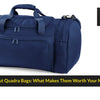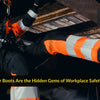Why Eye Protection is Essential in the Workplace
- by Mike Johnson

Why Eye Protection is Essential in the Workplace
Employers need to provide personal protective equipment (PPE) for their employees, and one of the most important pieces of PPE is eye protection. Without proper eye protection, employees can be subject to various long-term risks, including vision loss.
That's why it's so important for employers to provide employees with the necessary equipment and ensure that it is properly used and maintained. This guide will provide an overview of eye protection and why it is essential in the workplace.
We will cover the types of eye protection available, how to properly use and maintain them, and the potential risks associated with not using them. By understanding the importance of eye protection, employers can help ensure their employees' safety and create a safer workplace environment.
What is Personal Protective Equipment (PPE)?
PPE is any equipment employees wear that offers protection against specific health risks. PPE can be clothing, tools, or any other item used in a particular job. PPE is used to reduce the risk of serious injuries due to hazards in the workplace.
It is important to note that PPE does not eliminate all risks. If employees do not follow safe work practices or adhere to company policies, PPE does not function as intended. In addition, PPE is not just for dangerous jobs. You may have noticed that many jobs are now required to wear PPE. For example, doctors and nurses now wear PPE when treating patients. Dry, clean only PPE is also used to reduce the risk of transmitting certain diseases.
Types of Eye Protection Equipment
There are a variety of different types and styles of eye protection available.
Safety glasses - this eye protection is composed of two lenses designed to fit over the user's eyes in the form of glasses.
Goggles cover the eyes and surrounding eye area and are designed to protect the eyes from eye injuries and face protection from impacts. There are various styles of goggles, and some are designed to be used as both face and eye protection against potential hazards.
How to Properly Use and Maintain Eye Protection PPE
When using eye protection, take extra care to ensure the lenses are clean and free of any debris. In addition, keep the lenses and the entire set of PPE clean and dry. If moisture collects inside the lenses, it can cause damage that could reduce their effectiveness, and the set of PPE may need to be washed and dried.
While eye protection is designed to be worn for a specific period, it must be properly maintained between uses to ensure its effectiveness. To properly maintain eye protection, remove the lens from the set, then gently wipe the lenses with a clean cloth. Make sure to wipe both the inside and outside of the lenses. Next, dry the lenses with a clean cloth before replacing them. Give the PPE set an occasional wipe-down with an anti-static agent. This will help prevent any dust or dirt build-up inside the PPE, which can reduce its effectiveness.
Potential Risks of Not Using Eye Protection
PPE is designed to protect employees from certain health risks. While no PPE will provide 100% protection, it can significantly reduce the risk of injury. Employees who do not wear PPE could be at risk of serious injuries, such as a malfunctioning machine, falling from a height, or being exposed to hazardous materials. Potential risks of not using PPE include:
Impaired vision: Not wearing proper eye protection can lead to vision damage. This type of damage is often referred to as ocular damage, and it can occur because of cataracts, diabetic retinopathy, or other eye diseases that affect the eyes.
Personal injury: Not wearing proper eye protection can also lead to serious personal injuries. This includes cuts, scrapes, and falls that can result in a broken bone.
PPE malfunctions: Not using proper PPE in some jobs, like construction, farming, and mining, can increase the risk of injury. For example, workers may be exposed to dangerous machinery or toxic substances without proper PPE.
Infectious exposure: In some industries, such as agriculture or food preparation, workers may be exposed to infectious diseases, such as hepatitis, HIV, or the flu.
Conclusion: Why Eye Protection is Essential in the Workplace
Eye protection is an essential part of a worker's PPE, and employers need to provide their employees with the proper equipment. The risk of serious injuries, such as hearing loss or vision damage, can be significantly reduced if employees wear eye and ear protection when working in a hazardous environment. This guide was meant to provide an overview of the eye protection and why it is essential in the workplace. We hope employers and employees can use this information to better protect themselves from potential risks.
- Posted in:
- eye protection
- Personal Protection Equipment





